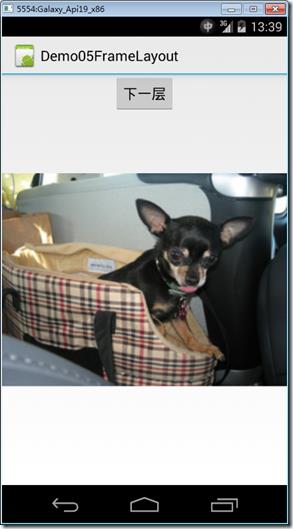FrameLayout(帧布局)
Posted
tags:
篇首语:本文由小常识网(cha138.com)小编为大家整理,主要介绍了FrameLayout(帧布局)相关的知识,希望对你有一定的参考价值。
分类:C#、android、VS2015;
创建日期:2016-02-11
一、简介
帧布局是显示多个层次图的有效手段。比如第3章介绍的百度地图就是利用帧布局来实现的,它将图层分为22级分别缓存到指定的文件夹下,程序根据用户对地图的放大程度,自动判断应该将哪一级作为最顶层的图层。另外,地图覆盖物功能也是利用它来实现的。
帧布局的特点是:所有元素都会从容器的左上角开始放置,第一个添加的元素被放在最底层,最后一个添加的元素放在在最顶层。默认情况下,上一层的元素会覆盖下一层的元素,除非不同层元素的大小不一样(其效果是部分覆盖),或者顶层的元素是透明的。
具体来说,对于不透明度为1(范围0.0~1.0,1为完全完全不透明)的元素,可进一步细分为:
(1)如果下层元素和上层元素的宽高都相同,则上层元素将完全覆盖下层元素。
(2)如果下层元素大,上层元素小,则上层元素仅部分覆盖下层元素。
二、示例—Demo05FrameLayout
本示例简单演示3个图层的情况:
第0层:img1.jpg
第1层:img2.jpg
第2层:img3.jpg
每单击一次【下一层】按钮,都会将图层减1,然后显示对应层的图。当减到第0层时,变为第2层,依次循环。
注意:该示例仅为了演示图层覆盖的情况(默认都可见,但仅顶层可看到),例子并没有处理如何缓存图片的问题。
1、运行截图
2、添加Demo05FrameLayout.axml文件
在Resources/layout文件夹下添加该文件。
<?xml version="1.0" encoding="utf-8"?> <FrameLayout xmlns:android="http://schemas.android.com/apk/res/android" android:layout_width="fill_parent" android:layout_height="fill_parent"> <ImageView android:id="@+id/image1" android:src="@drawable/sample_2" android:layout_width="fill_parent" android:layout_height="fill_parent" /> <ImageView android:id="@+id/image2" android:src="@drawable/sample_4" android:layout_width="fill_parent" android:layout_height="fill_parent" /> <ImageView android:id="@+id/image3" android:src="@drawable/sample_6" android:layout_width="fill_parent" android:layout_height="fill_parent" /> <Button android:id="@+id/btnNext" android:layout_width="wrap_content" android:layout_height="wrap_content" android:text="下一层" android:layout_gravity="center_horizontal" /> </FrameLayout>
3、添加Demo05FrameLayout.cs文件
在SrcDemos文件夹下添加该文件。
using System.Collections.Generic; using Android.App; using Android.OS; using Android.Views; using Android.Widget; namespace ch07demos.SrcDemos { [Activity(Label = "Demo05FrameLayout")] public class Demo05FrameLayout : Activity { List<ImageView> images = new List<ImageView>(); int current; protected override void OnCreate(Bundle savedInstanceState) { base.OnCreate(savedInstanceState); SetContentView(Resource.Layout.Demo05FrameLayout); images.Add(FindViewById<ImageView>(Resource.Id.image1)); images.Add(FindViewById<ImageView>(Resource.Id.image2)); images.Add(FindViewById<ImageView>(Resource.Id.image3)); current = images.Count - 1; FindViewById<Button>(Resource.Id.btnNext).Click +=delegate { images[current].Visibility = ViewStates.Invisible; current--; if (current < 0) current = images.Count - 1; images[current].Visibility = ViewStates.Visible; }; } } }
以上是关于FrameLayout(帧布局)的主要内容,如果未能解决你的问题,请参考以下文章
